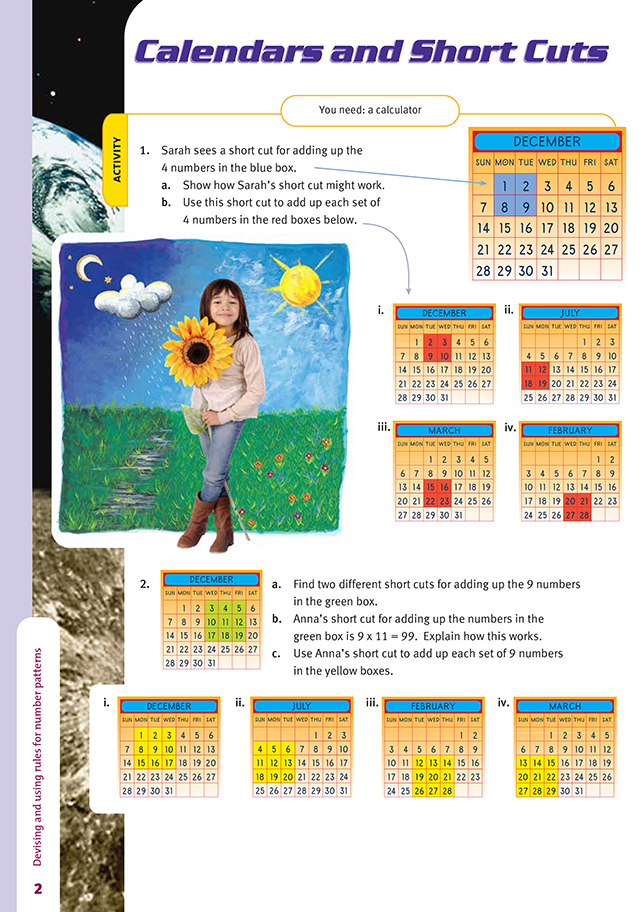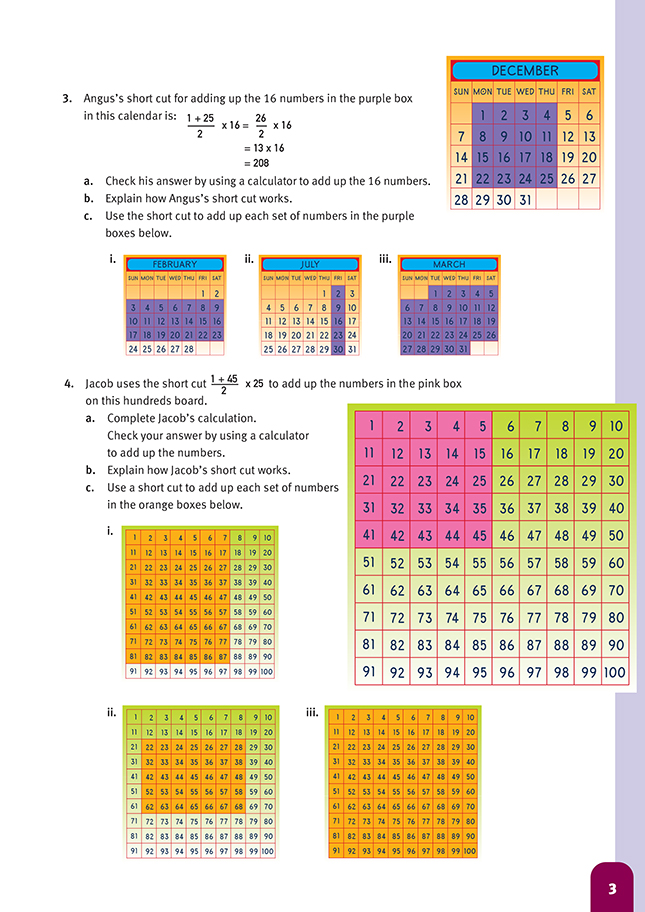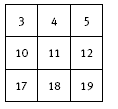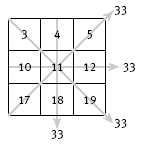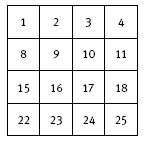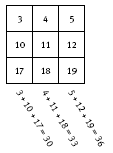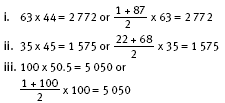This is a level 4 algebra strand activity from the Figure It Out series.
A PDF of the student activity is included.
Click on the image to enlarge it. Click again to close. Download PDF (165 KB)
use a rule to describe a pattern
FIO, Level 4+, Algebra, Book Four, Calendar and Short Cuts, pages 2-3
calculator
In this activity, students initially investigate short cuts for adding up sets of numbers shown on different calendar months. They then use these short cuts to devise rules for adding sets of numbers on hundreds boards, where the numbers are arranged consecutively from 1 to 100.
In question 1, the students look for a short cut to add 4 numbers arranged in a square.
The numbers in this arrangement were chosen because students usually see quickly that the numbers in the diagonals add up to 10.
When they have completed question 1b, encourage the students to write a simple rule for adding any set of 4 calendar numbers arranged in a square. One rule is: add the pairs of numbers in a diagonal and double the result.
The following arrangements, based on the difference of 7 (because there are 7 days in a week), help show why this rule works.
Note that the sum of the numbers in each diagonal above is 1 + 1 + 7 + 1 = 10, giving the total as 2 x 10 = 20. The sum of the numbers in each diagonal below is 15 + 15 + 7 + 1 = 38, giving the total as 2 x 38 = 76.
In general, any 4 numbers arranged in a square on a calendar grid will have the form:
So each diagonal will add up to n + n + 7 + 1 = 2n + 8, and the sum of both diagonals will be 2 x (2n + 8) = 4n + 16.
Students who follow this reasoning may use 2 x (2n + 8) = 4n +16 to develop two alternative rules. One rule would be: double the result of adding 8 to twice the first number (2 x (2n + 8)). The second rule would be: add 16 to 4 times the first number (4n + 16).
For example, the first number in this set of 4 numbers is 20:
So the sum of the 4 numbers is:
2 x (2 x 20 + 8) = 2 x 48
= 96
or 4 x 20 + 16 = 96
The arrangements below help to explain the short cut 9 x 11 used by Anna to add the 9 numbers shown in the calendar for question 2.
The students may notice that the numbers in each diagonal add up to 33, which is 3 x 11, and that the numbers in the centre column and the numbers in the centre row also each add up to 33. The question, then, is how to make use of this information. One approach is to add the results for the two diagonals to the sums for the centre column and for the centre row.
The students will see that this approach counts every cell in the grid once, except for the middle cell, which gets counted 4 times. (A cell is counted once for every line that passes through it.) So the total of all cells is: 33 + 33 + 33 + 33 – 3 x 11 (the sum of the 2 diagonals, the middle row, and the middle column minus 3 times the middle cell), which is 4 x 33 – 1 x 33, or 3 x 33 = 99. So a rule might be: 3 times the sum of the diagonal. We could also use the middle column or middle row.
The arrangement below shows how the short cuts work for question 2c iii.
The total of the numbers is 3 x 60 = 180 or, using Anna’s short cut, 9 x 20 = 180. Note that in each of the examples for question 2, short cuts lead to a rule for any similar arrangement of 9 numbers. The simplest rule, using Anna’s short cut, is: multiply the middle number by 9.
In question 3, Angus uses to calculate the total of the 16 numbers in the arrangement below.
Anna used the rule “multiply the middle number by 9” for calendar arrangements with 9 numbers. So Angus extends the rule to “multiply the middle number by 16” for calendar arrangements with 16 numbers.
Note that, with 16 numbers, the middle number (in this case, 13) does not show within the grid. The students may need to convince themselves that 13 is indeed the middle number for any “balanced” pair of cells in this grid. For example, for 9 and 17 or 8 and 18:
Two ways to calculate the middle number are shown in the Answers. The second arrangement below confirms that the total, 208, is 16 lots of 13.
The rule can also be applied to the set of 4 numbers in question 1. The middle number is hidden but can be calculated by working out the mean (average) of either 1 and 9 or 2 and 8. So the total of the 4 numbers is 4 x 5 = 20 (the middle number multiplied by 4).
.gif)
In question 3c, the students use the following rule to calculate the totals:
So, for example, in question 3c iii, there are 31 numbers to be added. The first number is 1, and the last is 31. So the total is
x 31 = 496.
In question 4, the calendar short cuts and the rule that applies are extended to arrays of numbers that are located on a hundreds board. Short cuts such as those shown in the Answers lead to the algebraic rule for calculating the sum of consecutive whole numbers from 1 to any value, n. The rule is:
So, for example, if n = 100, the sum 1 + 2 + … + 99 + 100 can be calculated as
100 x (100 + 1)/2 = 100 x 50.5
= 5 050
Answers to Activity
1. a. Answers will vary. The simplest short cut is to first add the diagonal numbers and then add the two totals.
1. a. Answers will vary. The simplest short cut is to first add the diagonal numbers and then add the two totals.
b. i. (10 + 2) + (9 + 3) = 24 or 2 x (10 + 2) = 24
ii. (19 + 11) + (18 + 12) = 60 or 2 x (19 + 11) = 60
iii. (23 + 15) + (22 + 16) = 76 or 2 x (23 + 15) = 76
iv. (28 + 20) + (27 + 21) = 96 or 2 x (28 + 20) = 96
2. a. There are several sensible short cuts. Two are shown here. (Another short cut is the one that Anna uses in b.)
Short Cut 1:
So the short cut is 3 x (3 + 4 + 5) + 9 x 7 = 36 + 63
= 99.
Short cut 2:
So the short cut is 30 + 33 + 36, which is the same as 3 x 33 = 99.
b. Explanations may vary. All the other numbers in the grid can be written in relation to the middle number:
The sum of the numbers in the two shaded corner boxes is (11 – 8) + (11 + 8) = 11 + 11
= 2 x 11.
There are three other pairs of numbers that work like this. They are:
(11 – 7) + (11 + 7) = 2 x 11
(11 – 6) + (11 + 6) = 2 x 11
(11 – 1) + (11 + 1) = 2 x 11.
The sum of these 4 sets of numbers is 4 x 2 x 11, which is the same as 8 x 11. When
the middle number is added to this, the sum of the 9 numbers is 8 x 11 + 1 x 11 = 9 x 11. The rule can be expressed as “the number of numbers multiplied by the middle number”.
c. i. 9 x 9 = 81
ii. 9 x 12 = 108
iii. 9 x 20 = 180
iv. 9 x 21 = 189
3. a. Angus is correct. 1 + 2 + 3 + 4 + 8 + 9 + 10 + 11 + 15 + 16 + 17 + 18 + 22 + 23 + 24 + 25 = 208
b. Explanations may vary. Angus starts by finding the middle number in the square of 16 numbers. He uses two corner numbers, 1 and 25:
(You could also use 4 and 22 because the average of two diagonally opposed numbers is always the same as the average of their opposite pair.) As with the 9 numbers in the 3 by 3 array of numbers, the total of the 16 numbers can be
found from the rule “the number of numbers multiplied by the middle number” or, in Angus’s case, “the middle number multiplied by the number of numbers”. So the short cut is 16 x 13 = 208 or 13 x 16 = 208.
c. i. 21 x 13 = 273
ii. 5 x 16 = 80
iii. 31 x 16 = 496
4a.
b. Explanations may vary. As with the previous examples, the rule is: the number of numbers multiplied by the middle number. There are 25 numbers, and Jacob finds the middle number by adding up the smallest and the largest number and dividing the result by 2. The middle number is 23, so the total of the numbers is 25 x 23 = 575.
c. Possible short cuts include:
